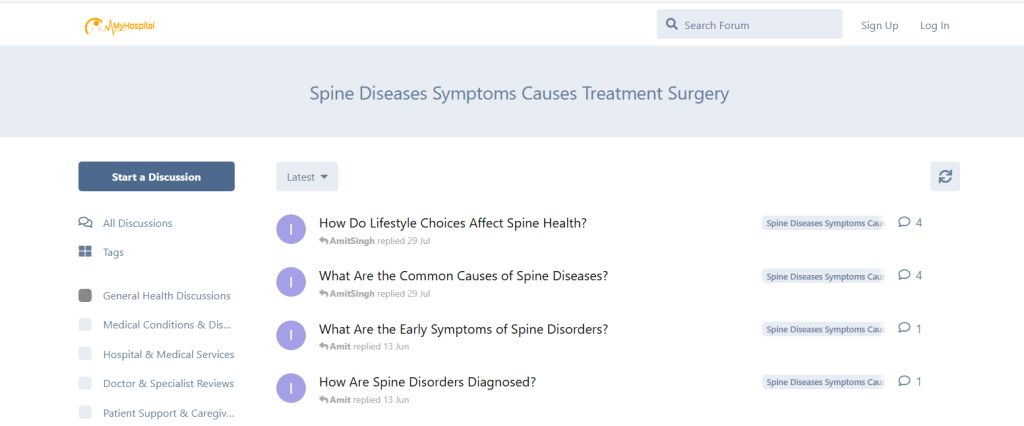
Back and spinal disorders—ranging from herniated discs and spinal stenosis to scoliosis and degenerative diseases—are among the world’s most disabling conditions. With spine surgeries now representing one of the top procedures sought by medical travelers, the industry is responding with radical innovation. Patients head to global centers in India, South Korea, Turkey, Thailand, and Europe, where advanced diagnostics, minimally invasive procedures, and personalized recovery pathways are the norm rather than the exception.
A Journey from Pain to Possibility
Consider the case of Raj, an active executive whose mobility was crippled by severe lumbar stenosis. After facing local waitlists and high costs, Raj explored options on MyHospitalnow and found a renowned hospital in South Korea. He received robotic-assisted decompression surgery, coupled with a tailored rehab package—returning to work and family life in under a month, with renewed confidence and function. On MyHospitalnow’s forum, stories like Raj’s inspire a wave of hope for people suffering from complex spinal issues.
Spine Medical Tourism at a Glance
- The spinal implant market will reach over $12.4 billion in 2025, driven by demand for advanced surgical solutions and medical travel.
- Orthopedic and spinal surgeries now make up a major share of all medical procedures sought internationally.
- Recovery time for minimally invasive spine surgeries abroad is often reduced by 50–70%, with patient satisfaction rates frequently topping 90%.
- Top centers in Asia and Europe report costs 40–70% lower than in Western nations, with bundled packages often including rehab, medication, and wellness stays.
Maximizing Outcomes in International Spine Care
- Choose expertise: Research accredited centers featured on MyHospitalnow, with transparent credentials and published outcomes.
- Ask about innovation: Leading centers offer robotic-guided surgery, endoscopic decompression, stem cell therapy, and aquatic physiotherapy.
- Plan full-cycle care: Look for programs that include pre-op counseling, travel logistics, onsite translators, and ongoing virtual support for best outcomes.
- Tap into community: Leverage the MyHospitalnow forum to share recovery journeys, review providers, and discover real-life tips from successful patients.
Explore trusted resources, advice, and trending discussions at:
- Blogs, guides, and specialist insights: MyHospitalnow Blog
- Q&A and success stories: Spine Diseases Forum
Actionable Tips for Every Spine Health Traveler
- Bring past MRI scans and diagnosis records for precise treatment planning.
- Confirm your destination hospital’s rehab protocol—strong recovery programs are key to lasting results.
- Ask about minimally invasive options, lower risk of surgical site infections, and comprehensive aftercare for international patients.
- Connect with patients who have undergone similar procedures for honest recommendations on destinations, logistics, and lifestyle modifications.
Case Study Spotlight/The Rapid Recovery Protocol: From Hospital to Home in 12 Hours
Elite medical tourism centers have transformed ESS into a highly efficient, high-volume procedure, prioritizing not just precision, but also the patient’s immediate quality of life.
Case Example (Storytelling): A retired school principal, Mrs. Anya, traveled for treatment after years of crippling sciatica caused by a herniated disc. She was apprehensive about another back surgery after witnessing a friend’s long, painful recovery from a traditional procedure. At a leading Asian spine center, her Full-Endoscopic Discectomy took 45 minutes. Because the muscle was merely dilated, not cut, she was walking pain-free within three hours and was safely discharged to her hotel the same evening. Her complete recovery timeline was weeks, not months. This speed and efficiency are key selling points for medical travelers eager to minimize their time abroad.
The three critical differentiators defining the most advanced ESS programs are:
A. Breakthrough 1: True Muscle-Sparing Approach
Unlike other minimally invasive techniques that still require some tissue cutting, the endoscopic tube is often inserted between the muscle fibers, known as a muscle-sparing technique. This anatomical approach is the primary reason for the dramatically accelerated recovery.
B. Breakthrough 2: Ultra-High Definition Visualization
The endoscope provides magnification and illumination far superior to the naked eye. Surgeons get a high-definition, panoramic view of the spinal canal, allowing them to target the compression point (herniated disc, bone spur) with unparalleled accuracy, minimizing the risk of nerve root injury.
C. Breakthrough 3: Focus on Awake Surgery (Local Anesthesia)
Many ESS procedures can be performed under local anesthesia and light sedation. This allows the surgeon to communicate with the patient during the procedure, confirming that the compressed nerve root has been successfully decompressed—a real-time functional confirmation impossible under general anesthesia.
Your Path to a Pain-Free Future Starts with an Informed Choice
Living with chronic spine pain can feel like a prison. But the walls of that prison are crumbling, thanks to global advances in medical technology and the democratization of world-class healthcare. By looking beyond borders, you are not just seeking a surgeon; you are strategically accessing a higher standard of spinal care and a faster track back to the life you love.